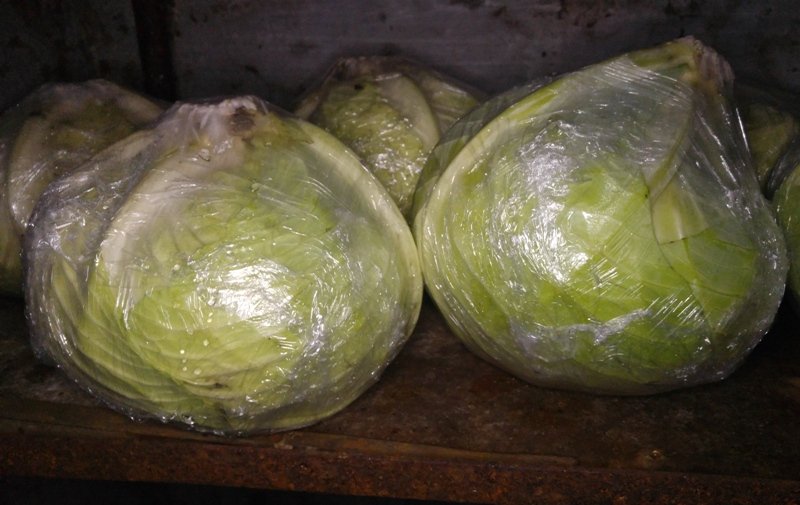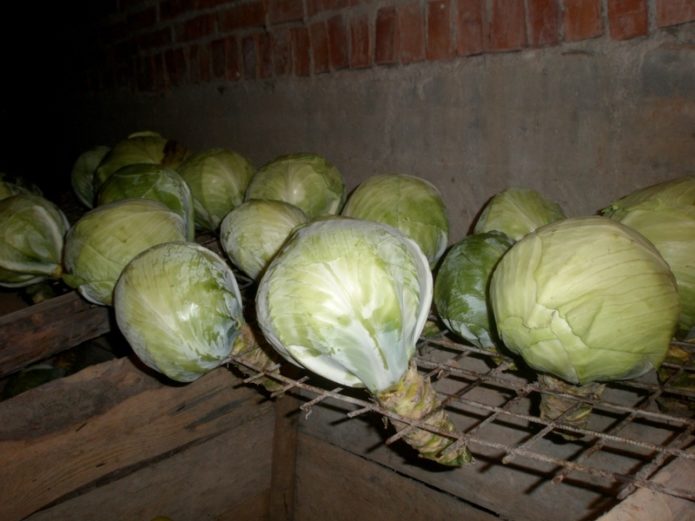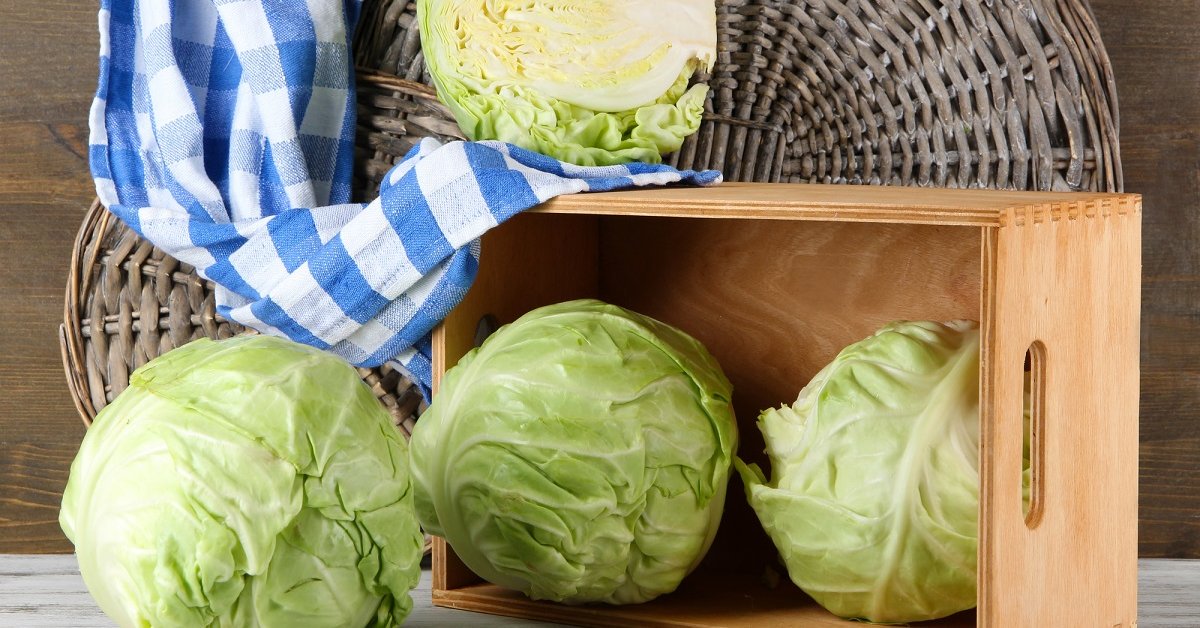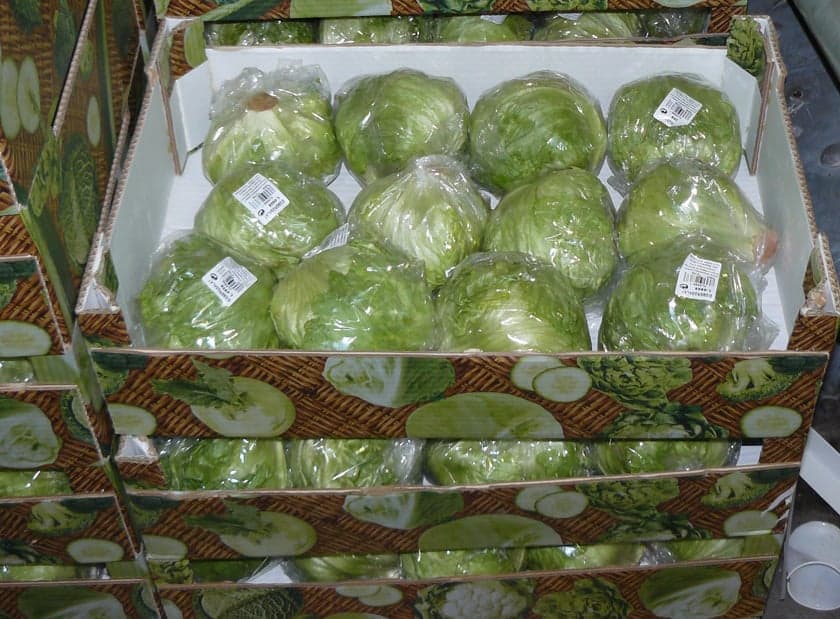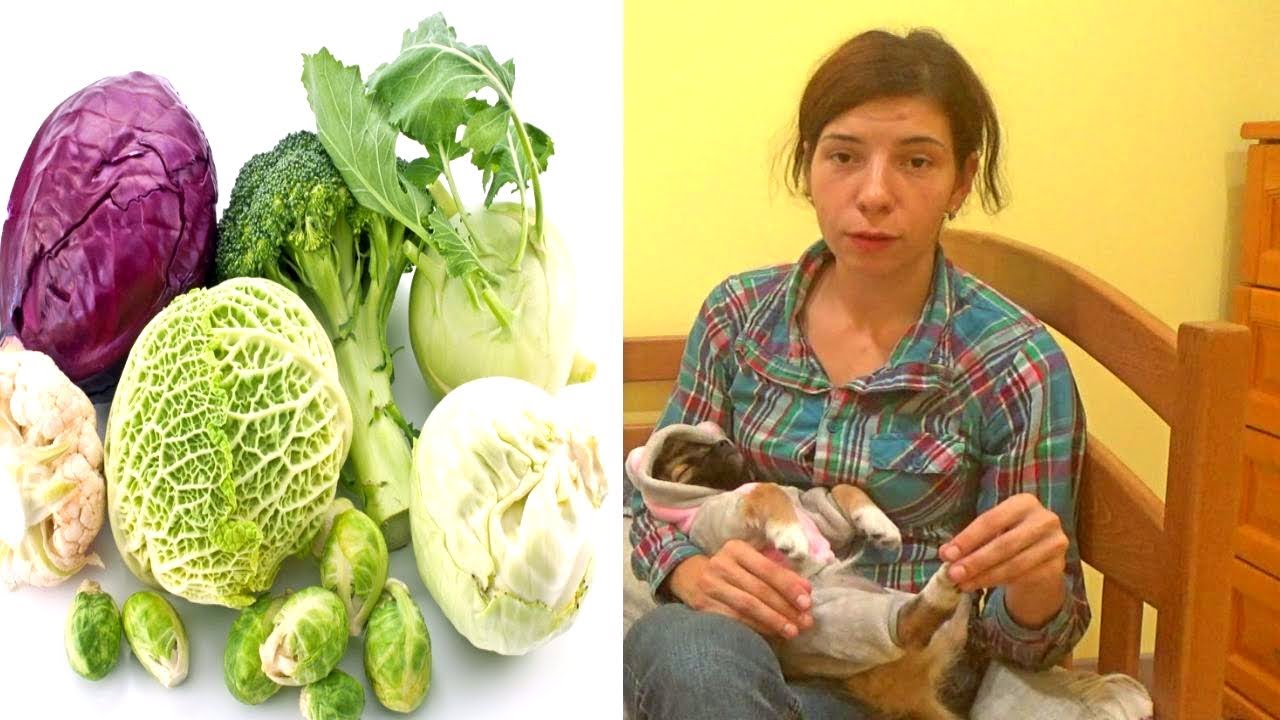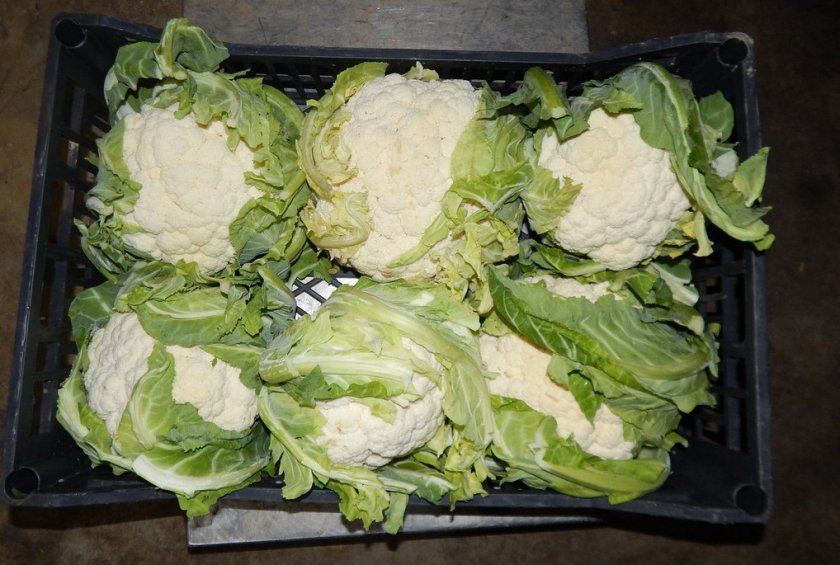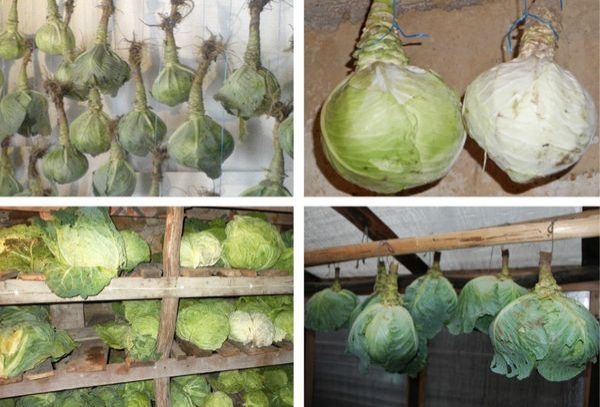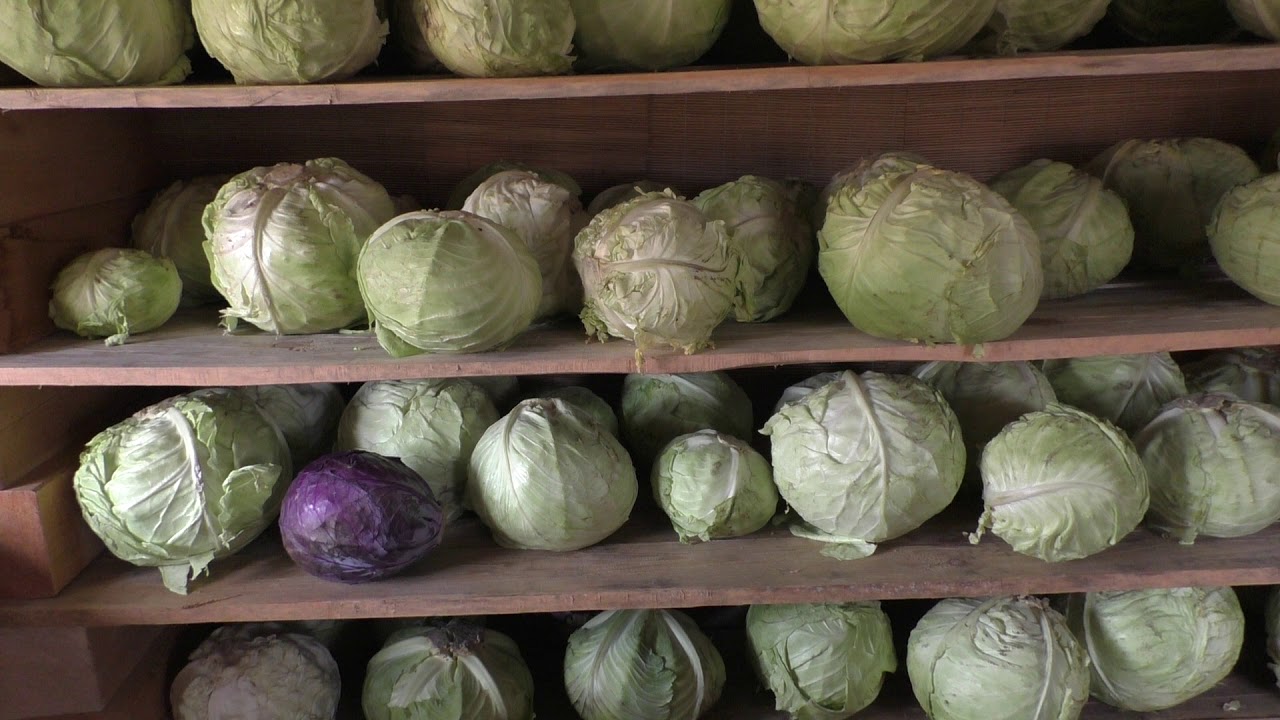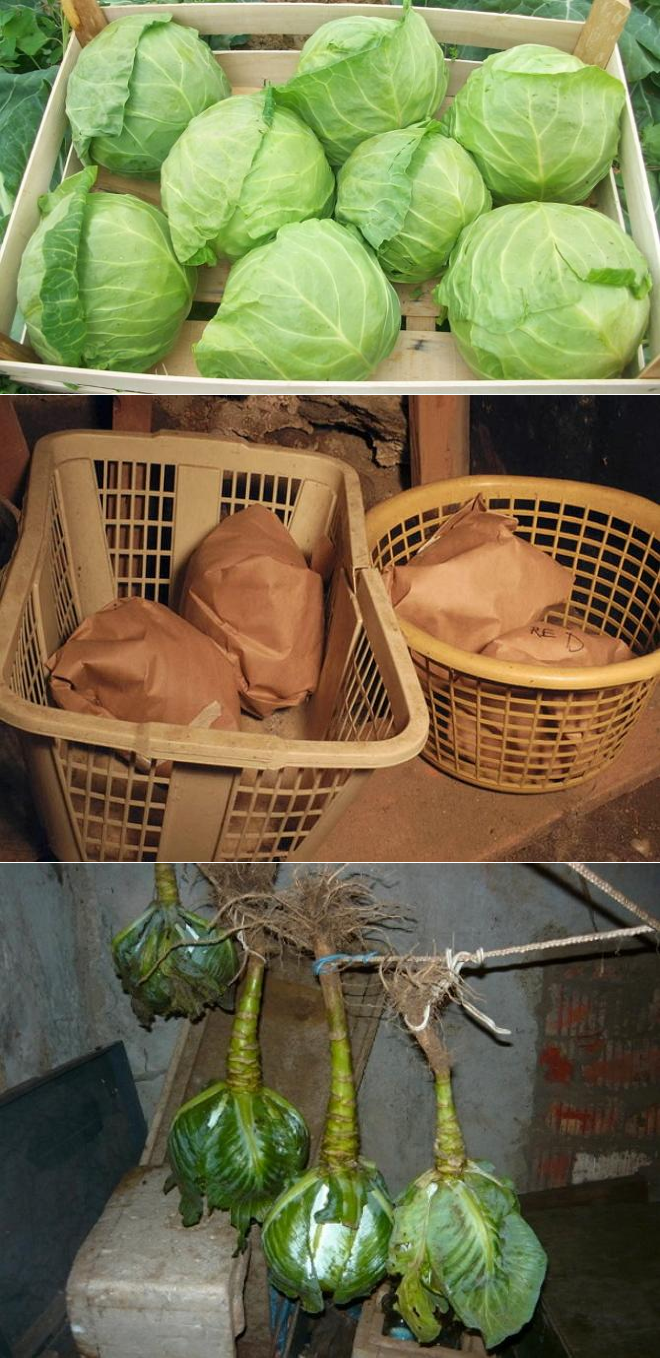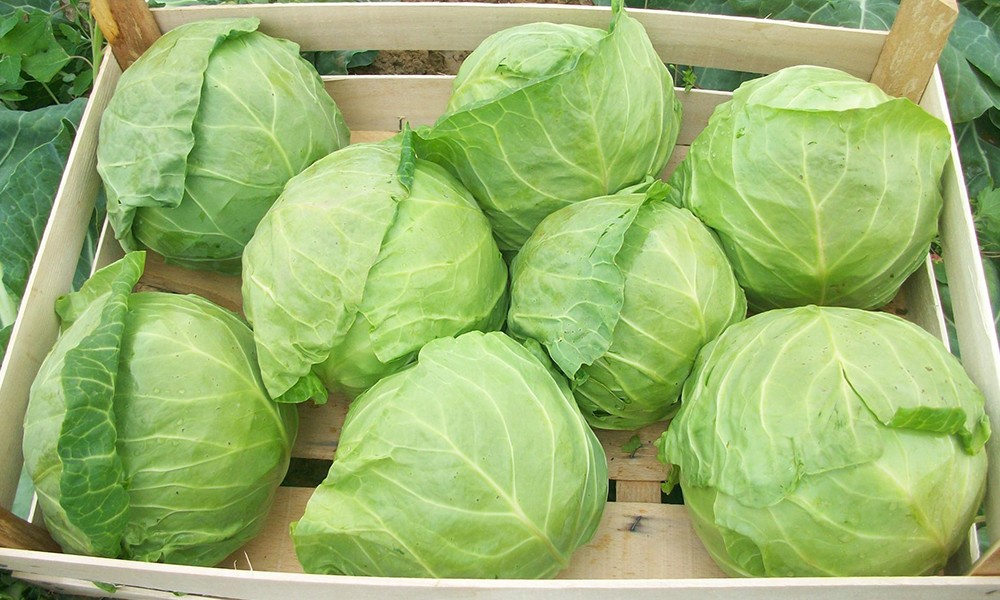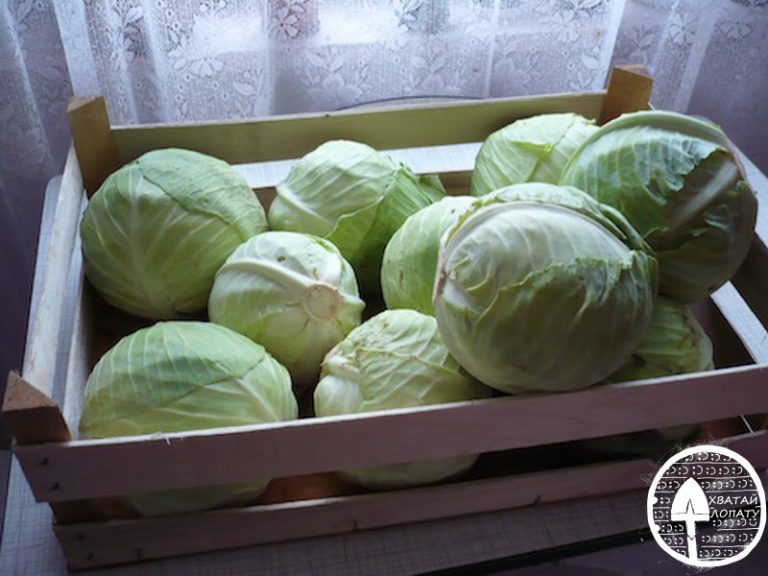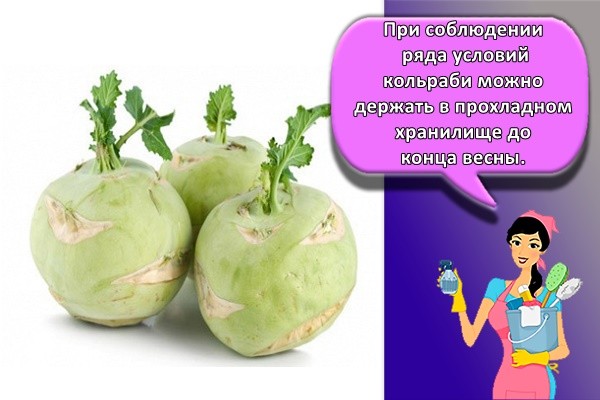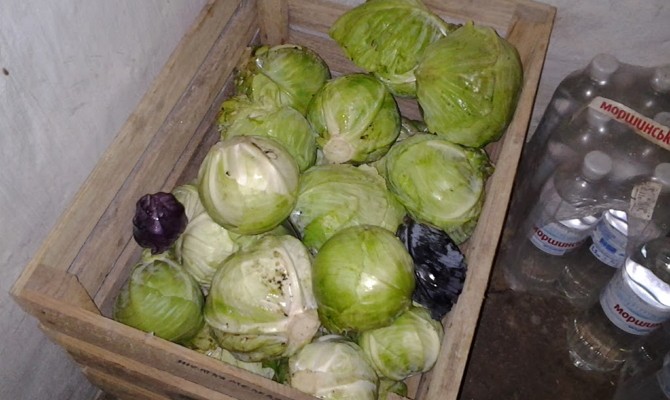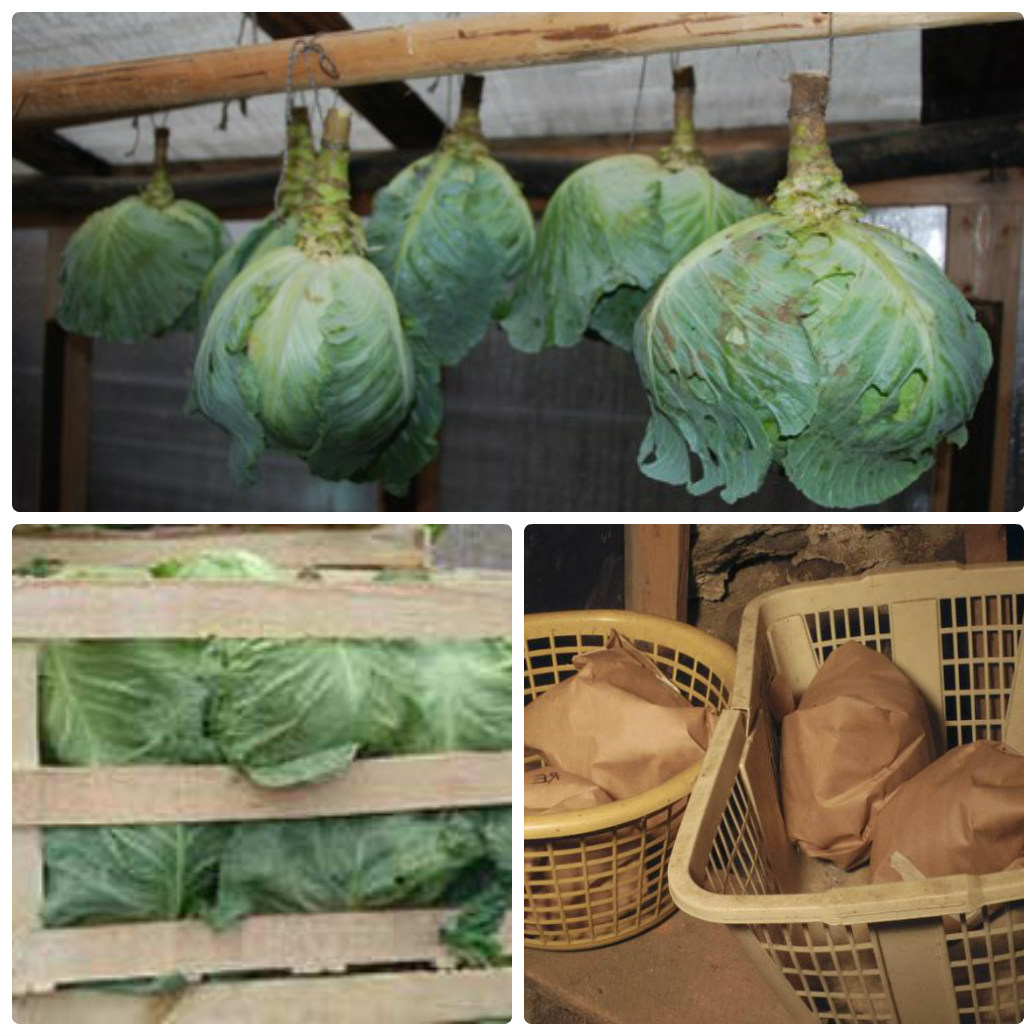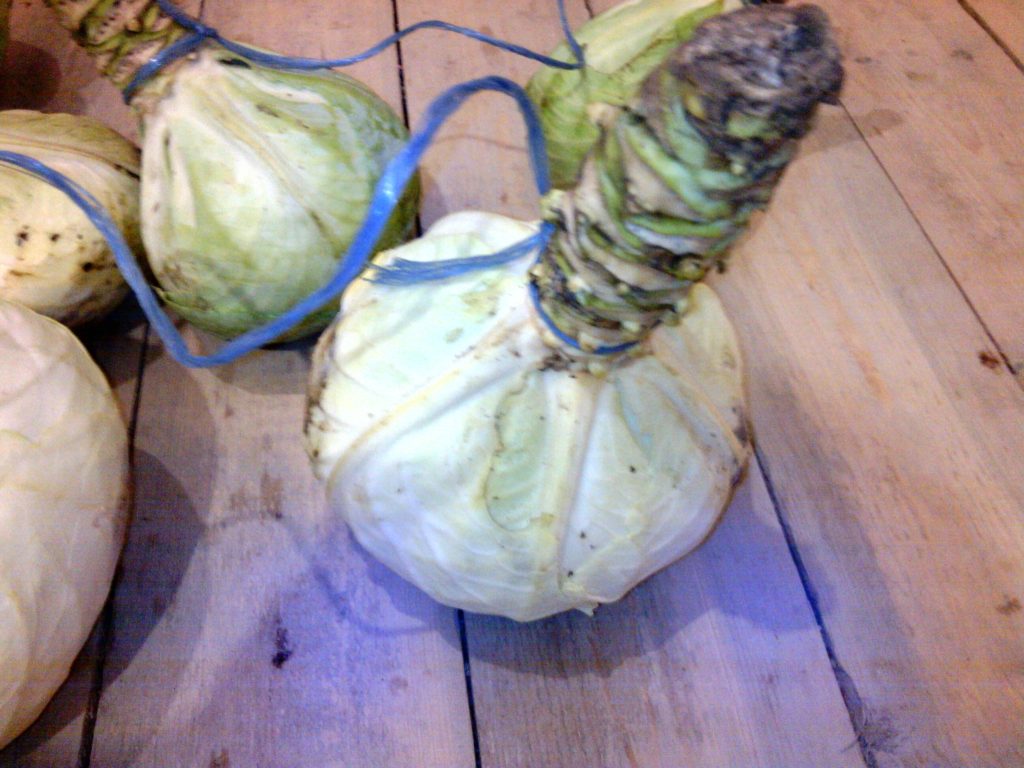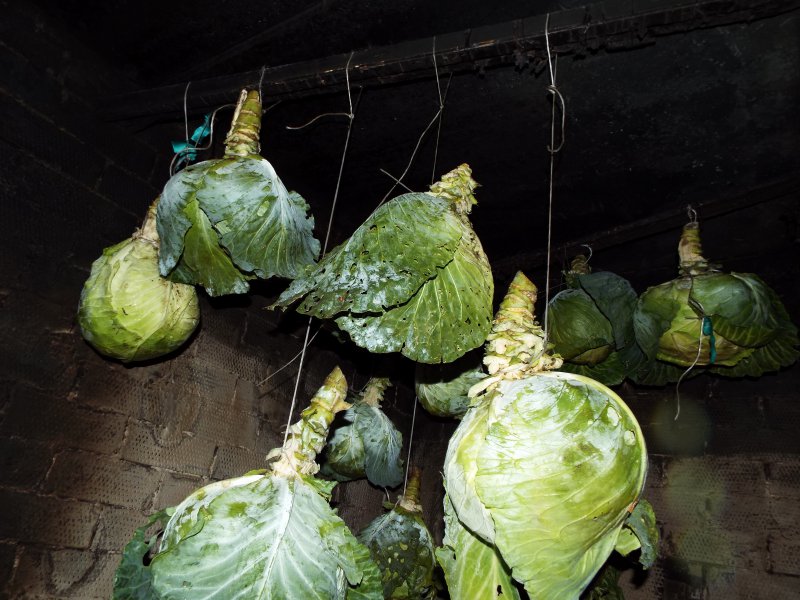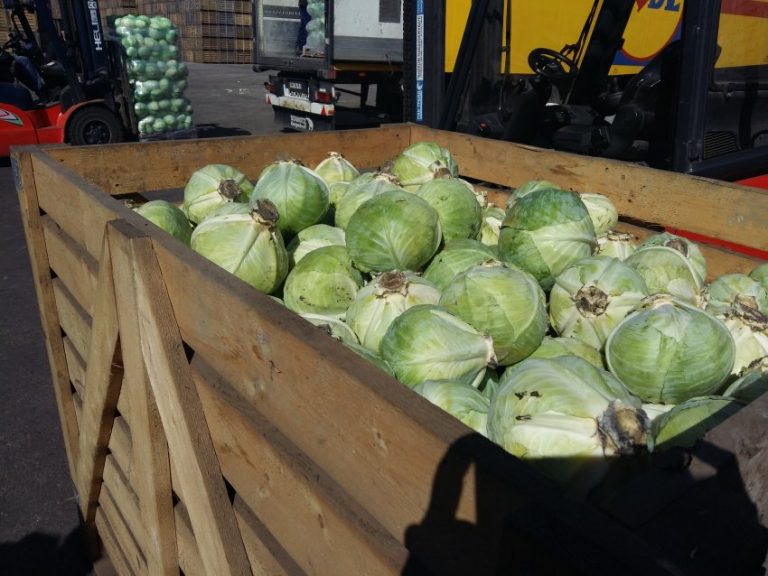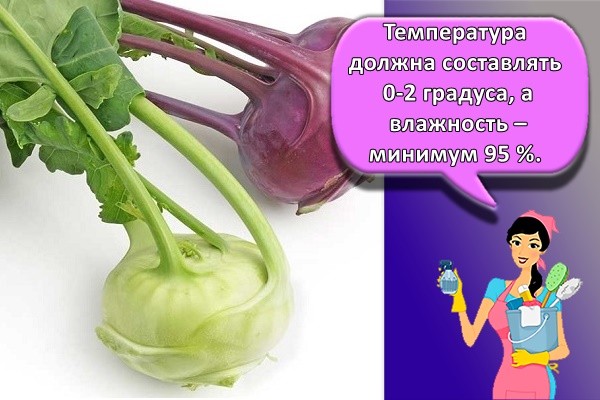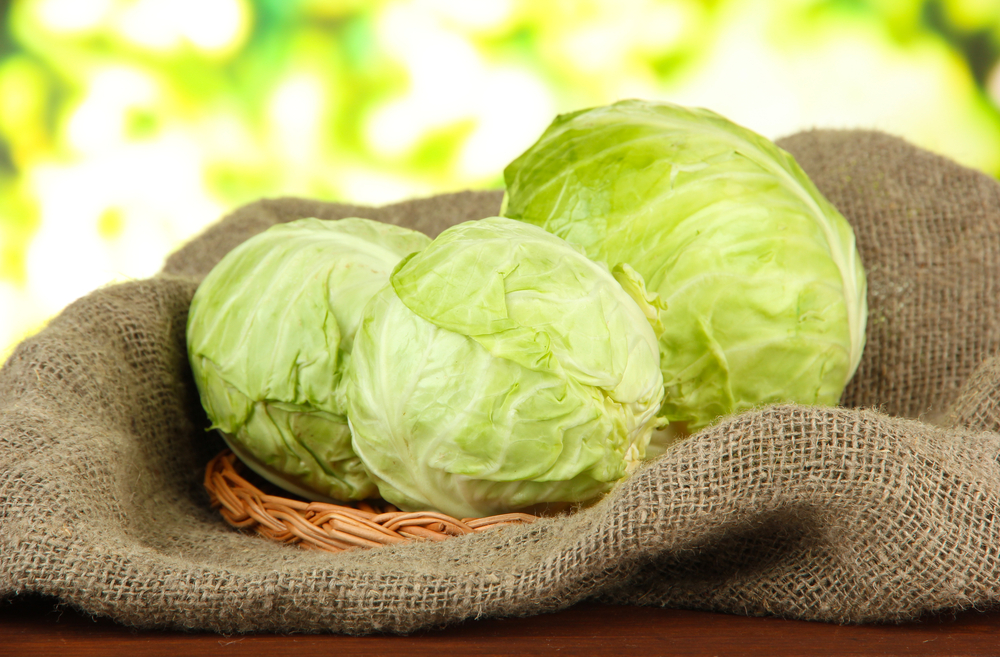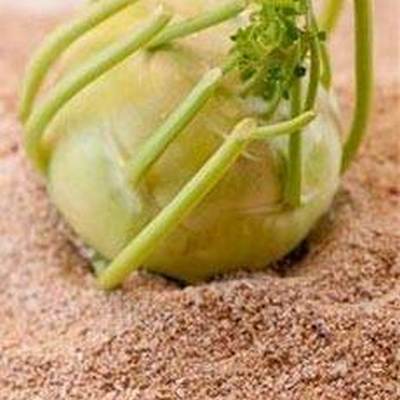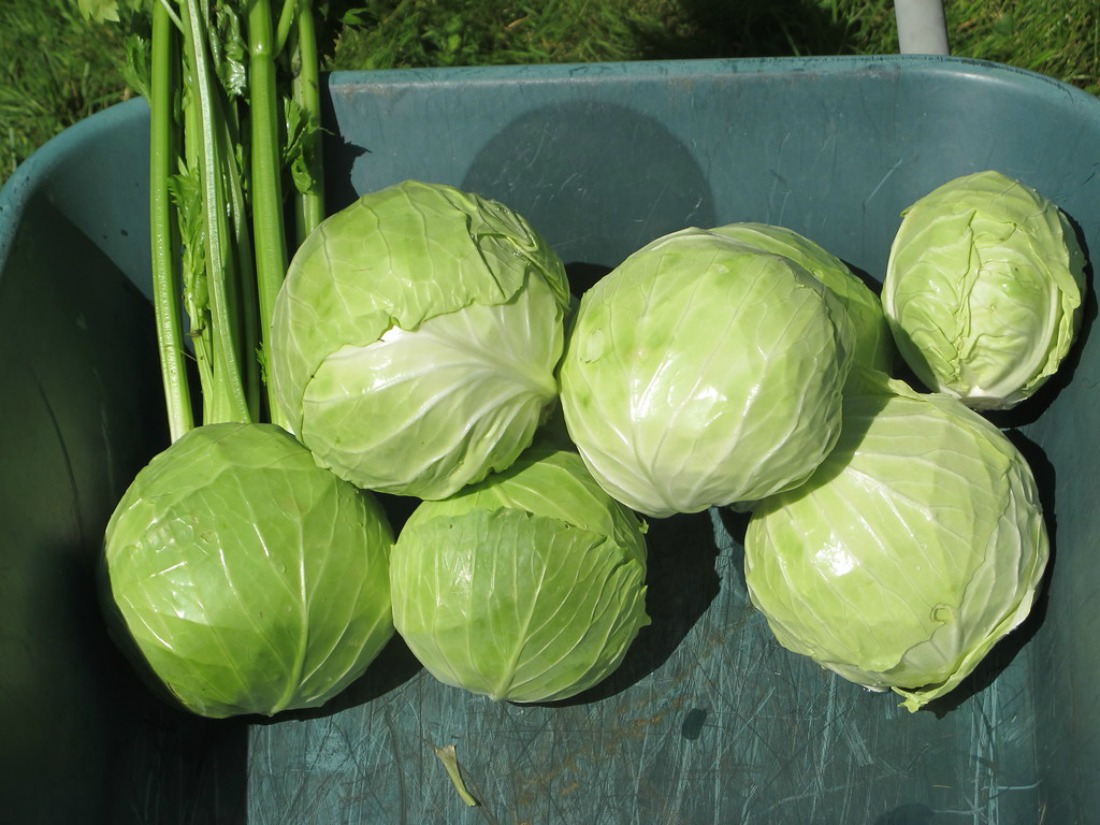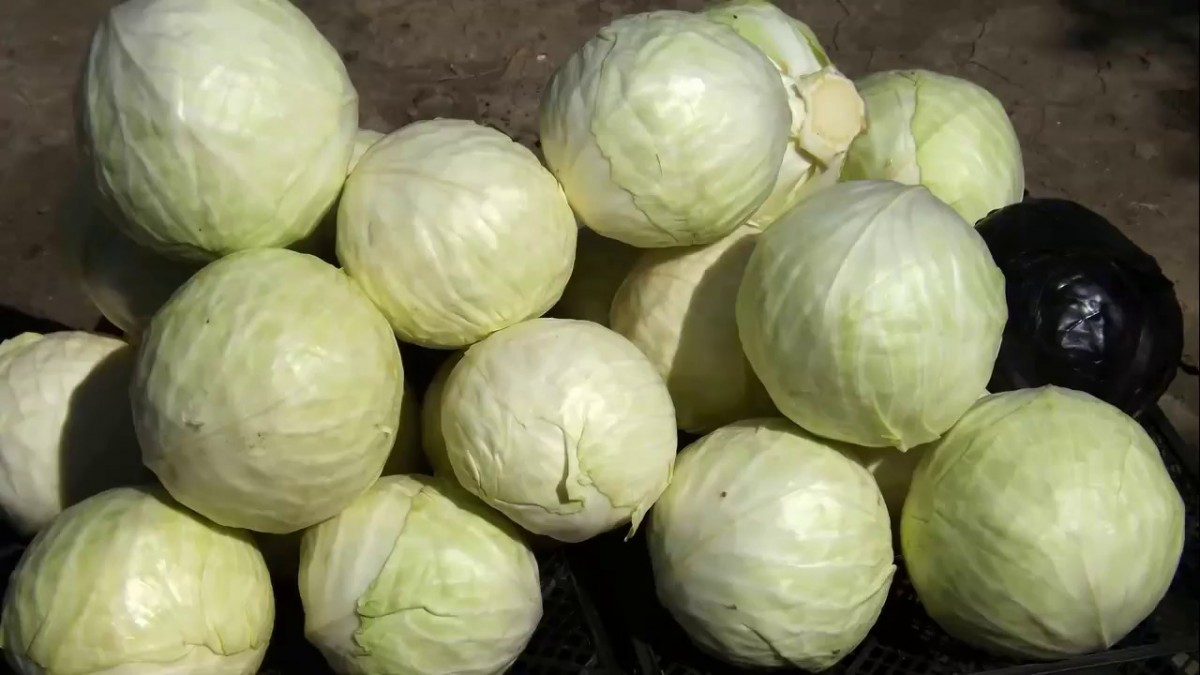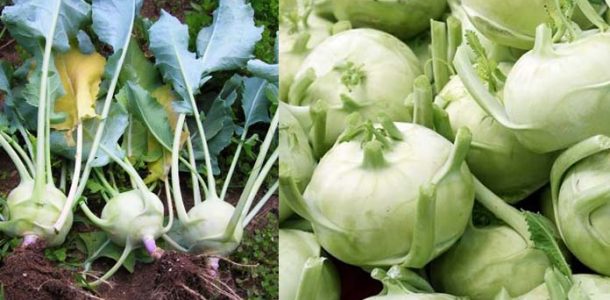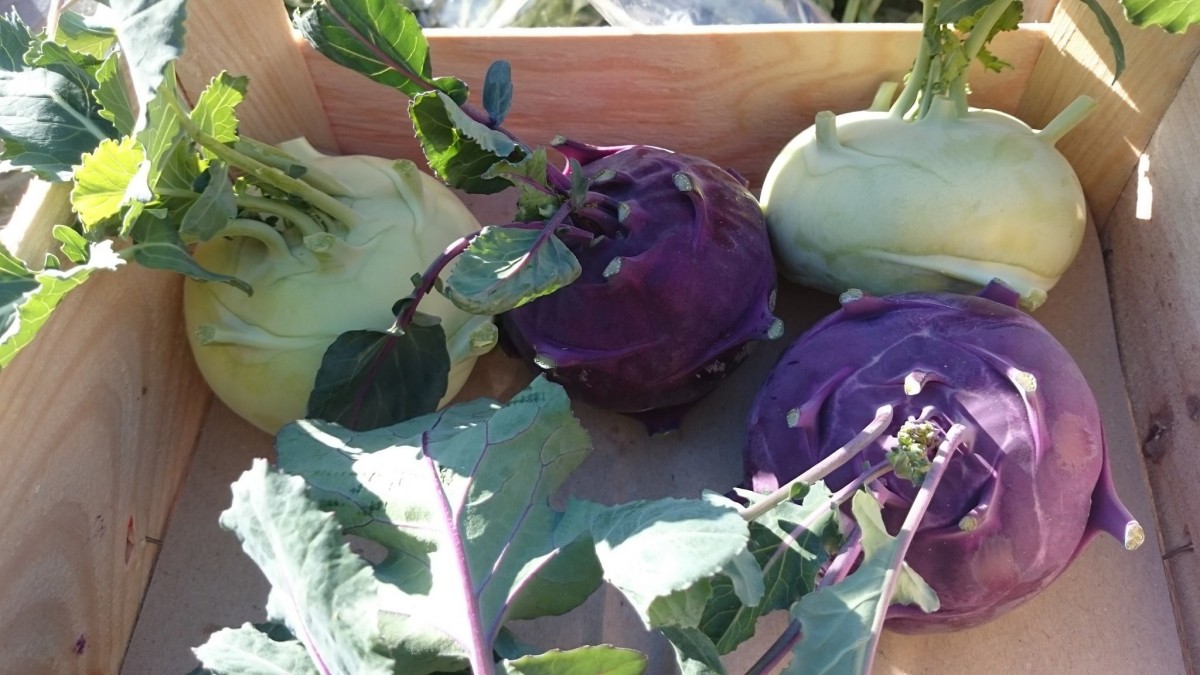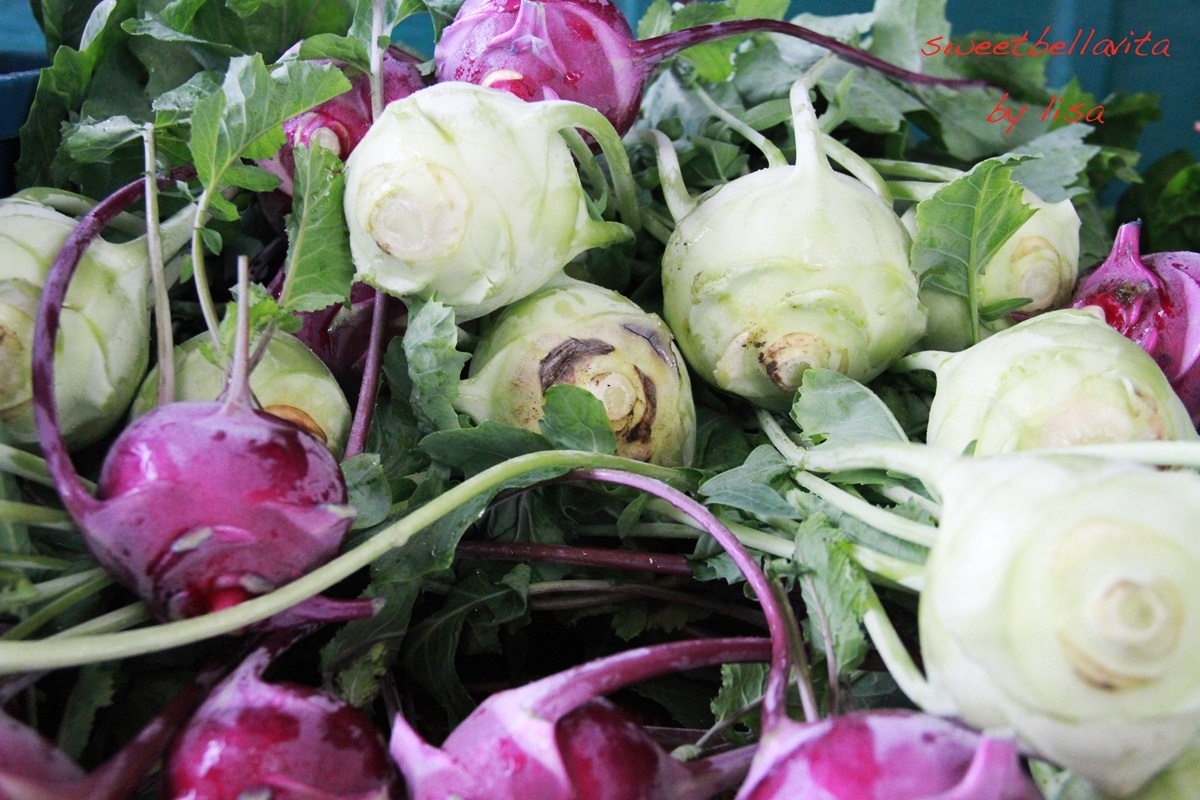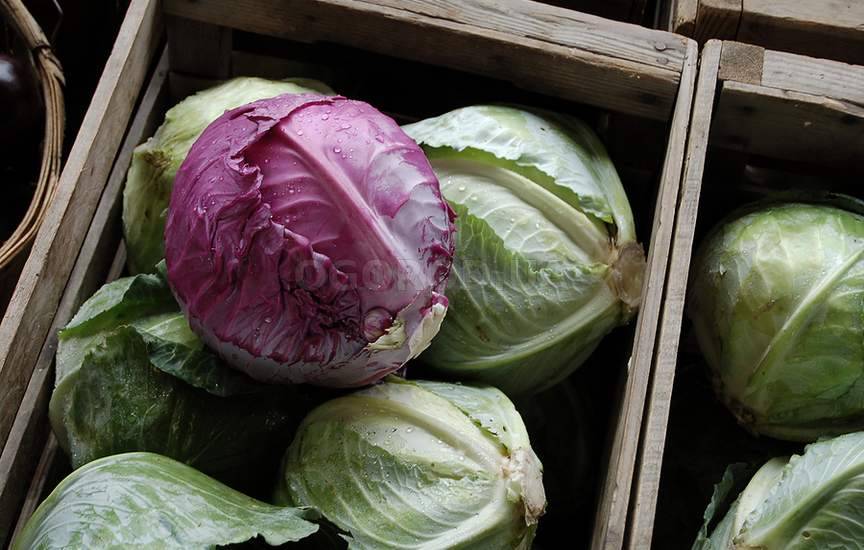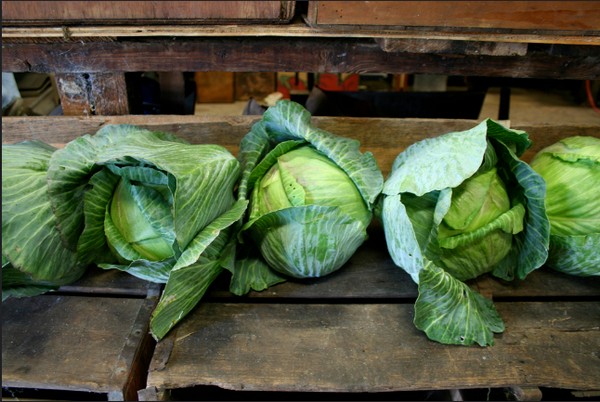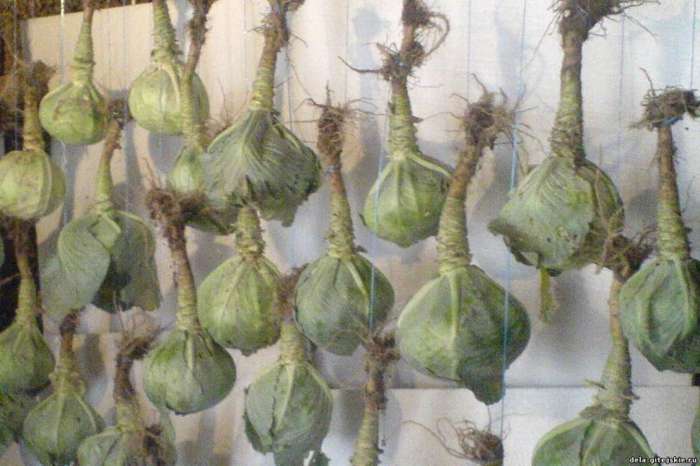Home storage
When the necessary conditions are created, kohlrabi cabbage can be stored for up to 5-6 months:
- temperature + 2 ... + 4 ° С;
- relative humidity 90-95%.
In this case, even early varieties of cabbage are able to maintain freshness for 2-3 months, and later varieties will supply vitamins until spring.
Cellar storage
The best place to store vegetables in winter is in the cellar. With this method, cabbage is able not to lose its beneficial properties until spring.
It is very important that the vegetables are dry and free of soil residues. Not all fruits are suitable for storage
It is necessary to reject stem crops:
- immature, small (less than 7 cm);
- with traces left by pests or diseases;
- with damage (dents, cuts, etc.).
Storing cabbage in basements or cellars is possible in several ways:
- Prepared vegetables are laid out in boxes or baskets, then sprinkled on top with slightly damp clean sand. Then they cover themselves with plastic wrap. This is not done very tightly, otherwise the cabbage may rot and rot will begin. It is allowed to lay out the heads of cabbage on special grating or in compartments.
- You can save kohlrabi in the cellar on the floor in wet sand. To do this, a layer of sand is scattered on the floor, its thickness should be at least 7-10 cm. The stems are stuck into it with their roots down. They need to be "planted" in such a way that they do not touch each other. Otherwise, they will inevitably deteriorate.
- Sometimes kohlrabi for the winter are advised to be hung on a wire or rope to special hooks on the ceiling. Here, a very important condition is a fairly free arrangement of the fruits. The distance between adjacent fruits should be at least 2-3 cm.
Cold storage
In the absence of a cellar, you can try to keep kohlrabi cabbage at home in the refrigerator. Immediately after harvesting, the roots and leaves should be cut off from the stem tubers, leaving cuttings 8-10 cm long. This is necessary so that the greens do not draw juices from the rhizome, otherwise the fruit will quickly become flabby. It also reduces the likelihood of an infection that can provoke rotting.

Each head of cabbage must be wrapped in paper or cotton cloth. You can use canvas bags.
The vegetables are then placed in a plastic bag that should not be tied tightly. There must be air access. You do not need to wrap the fruit with paper, but simply put a damp cloth in the bag. Thus, the fruits are stored for up to 2 months without losing their taste and freshness.
Kohlrabi can be stored in the freezer during the winter. This is a very good method, although frozen vegetables are not entirely suitable for making fresh salads. But nutrients and vitamins are fully preserved.
The freezing technology is as follows:
- the stems need to be washed thoroughly;
- to peel;
- cut into pieces about 2 cm thick;
- dip in boiling water for a couple of minutes;
- then quickly move into very cold water (preferably ice cold);
- throw in a colander;
- dry by laying out on a towel;
- decompose into individual sachets or containers;
- store in the freezer.
You can grind the fruits on a grater with the largest cells. Such cabbage does not need to be blanched. It can be immediately divided into sachets and stored in the freezer. In this form, cabbage is perfectly stored for up to 9-10 months.
There are many recipes for cooking various pickles and marinades from kohlrabi cabbage. They are already ready-to-eat dishes and retain a significant part of their beneficial qualities.
As you have seen, the rules for storing kohlrabi cabbage are not at all tricky, spending a little time and effort, you can provide yourself with vitamins for the whole winter.
Before storing, we will select an applicant ...
Before puzzling over how to store kohlrabi cabbage, it is worth finding those varieties that are genetically more resistant to storage without land. They should be planted first of all next year.
There are two types of kohlrabi available in Russia: white (aka light green) and purple-skinned. But both of them have a creamy yellowish or milky center.
Only late and mid-late varieties and hybrids are good for long-term storage. At the same time, kohlrabi painted in lilac and lilac tones are best preserved. These are representatives of such varieties as
- Of the giant
- Violetta
- Hummingbird F1
- Delicacy blue
Milky green varieties are less suitable for long-term storage, but Kossak F1, Sonata F1 and Moravia are stored relatively well. After at least 45-60 days, they do not lose their taste or texture, which is similar in appearance to a potato tuber.
How to choose and prepare cabbage for winter storage
For storage, you need to select the densest, heaviest heads of cabbage
When buying in a store, you need to pay attention to the condition of the uppermost leaves - they should be green, rich in color, elastic. Dry integumentary leaves indicate that the head of cabbage was cut from the garden for a long time - such products will not be stored for a long time
If the culture is grown at home, then the heads of cabbage can be left in the beds until the air temperature drops to -5 ... -7 ° С.
This approach helps to improve the palatability and extend the shelf life of the cabbage. If the autumn is rainy and warm, then the harvest is postponed until the end of October - mid-November. Wet forks are very poorly preserved, therefore, 5-6 days before cutting, they need to be covered with a film so that they can dry out. If you plan to store the heads of cabbage by the root, then the plants are dug up. If the root is not needed, cut with a sharp, clean knife.
Important! Heads of cabbage lighter than 500 g will dry out quickly, so it is better to send them for quick processing. Next, all products need to be sorted
For storage, heads of cabbage of at least 500 g weighing, dense, green, without signs of damage by diseases and pests are taken. The products prepared for storage are sprinkled with crushed chalk and laid out in a dry room on shelves or cloth mat. In this state, the forks are left for 2-3 days. Then the stump is shortened to 3 cm
Further, all products must be sorted. For storage, heads of cabbage of at least 500 g weighing, dense, green, without signs of damage from diseases and pests are taken. Products prepared for storage are poured with crushed chalk and laid out in a dry room on shelves or on a cloth mat. In this state, the forks are left for 2-3 days. Then the stump is shortened to 3 cm.

Fundamental rules
How to save Savoy cabbage for the winter? Savoy cabbage, which is intended for winter storage, is recommended to be harvested at a temperature of at least -7 degrees, while it is desirable that such heads of cabbage weigh at least 500 grams and have at least two or three tight-fitting and rigid covering sheets: they will serve as reliable protection against ingress dirt and damage.
It is not recommended to water the cabbage to be stored before harvesting, and it is advisable to cut the cabbage in dry weather. Frozen cabbage and heads of cabbage that have signs of rot or are affected by pests or fungi will not withstand long storage.
Immediately before sending the heads of cabbage for storage, they must be slightly dried - for this, sprinkle them with crushed chalk and spread them out in a dry room on lattice shelves for a couple of days. The stump of such heads of cabbage should be shortened, leaving no more than three centimeters.
What and where to store Savoy cabbage?
It is assumed that Savoy cabbage can be stored from four months to six months: the heads of cabbage can withstand this period without problems if they are stored in wooden boxes, while placing the heads close to each other is impossible: there should be gaps of several centimeters between them. The cabbage is stored with the stump cut up.
It is permissible to store cabbage in a suspended state: heads of cabbage should be laid in nets and suspended from the ceiling on a string, while the net should be separate for each head of cabbage, and dense "neighborhood" in this case is also inappropriate.
An ideal place for storing Savoy cabbage for the winter will be a garage, basement or cellar, but only if the temperature regime is observed (cabbage storage is permissible at temperatures from 0 to +3 degrees) and with appropriate air humidity, which should be 90- 95%.
If the cabbage is stored in the cellar, it is necessary to take measures in advance to eliminate rodents in it, as well as to make sure that there is no fungus and mold in this room. Additionally, it is recommended to treat the entire room with antiseptic agents.
Observing these rules, it is possible to ensure long-term storage of Savoy cabbage for six months, and if the heads of cabbage are large (from six kilograms) and the storage process is constantly monitored, late varieties can be stored for up to 12 months.
When to cut for storage
For long-term storage, the heads of cabbage are cut down, leaving a long stump. The harvest time depends on the variety. In temperate climates, cabbage is grown, which forms a stem crop in 60-70 days. You should not wait until it reaches a large size.
In large heads of cabbage, the skin coarsens, the flesh loses its juiciness, and tough fibers appear in it. The optimum diameter of the fruit for storage is 8 cm. Harvesting is carried out on a clear, sunny day, frost is not expected. Light frosts are not terrible for culture, but heads of cabbage, felled before frost, lie better.
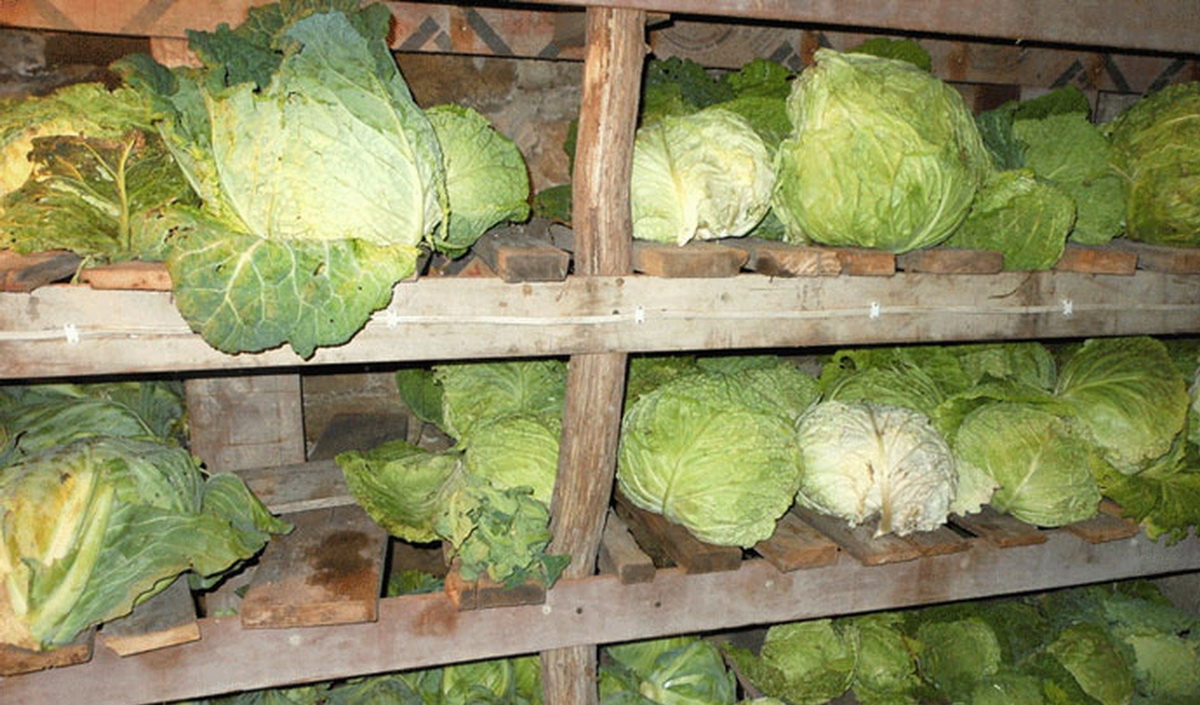
How to properly store cabbage in forks It's hard to imagine our table without this vegetable. Borscht, stewed, sauerkraut are three favorite dishes for many. In order not to ...
Storage preparation
 For long-term storage, the head of cabbage (stem plant) is not cut down. It is pulled out along with the root. All leaves are cut off, leaving not long petioles - 1.5 cm. They are not thrown away. There are 2 times more vitamins in the tops than in the pulp. While they are fresh, firm, they are added to salads, first courses.
For long-term storage, the head of cabbage (stem plant) is not cut down. It is pulled out along with the root. All leaves are cut off, leaving not long petioles - 1.5 cm. They are not thrown away. There are 2 times more vitamins in the tops than in the pulp. While they are fresh, firm, they are added to salads, first courses.
Washed, dried leaves are stored in the refrigerator for several days. They are placed in a bag or plastic container. Tops covered with black dots are not suitable for food. It is a sign that the vegetable has a high concentration of nitrates.
Ways to store cabbage at home
At room temperature, kohlrabi cabbage can stay fresh for only a few days, so for longer storage, the vegetable must be kept in special conditions. You can process the product by preparing tasty canned preparations from it, but at the same time kohlrabi will partially lose its taste and useful chemical composition. In order to be able to feast on fresh vegetables until the very cold weather, they use various methods of storing it, listed later in the article.
Learn about recipes for preparing kohlrabi cabbage for the winter.
In fridge
In a city apartment, you can increase the shelf life of fresh kohlrabi cabbage using a refrigerator. This method allows you to preserve the freshness of the product for up to 5 weeks, provided that the stems have been properly prepared.
Basic rules for storing kohlrabi in the refrigerator:
- lightly shake fresh vegetables from dirt and cut off their tops - while it is recommended to leave small cuttings so that harmful microorganisms do not penetrate through the damaged pulp;
- wrap the stems with thick paper or a damp cloth and put them in a plastic bag, leaving it slightly open - this will prevent rot on the cabbage as a result of air stagnation;
- the cut tops can be folded into a separate bag and also placed in the refrigerator;
- you need to store kohlrabi in the vegetable drawer located at the bottom of the refrigerator.

In a cellar or basement
The most common way to store large quantities of fruit is in the cellar or basement. In such a room, you can create optimal microclimate conditions under which the product will be stored for 3-5 months.
Important! To keep the kohlrabi juicy and tasty during storage in the cellar, it is recommended to place it with its roots down.
Basic rules for storing kohlrabi cabbage in a cellar or basement:
- prepared stems are folded in a box or wide basket, placing them not too tightly to each other;
- a layer of wet sand is poured in a container with cabbage so that it partially covers the vegetables, and then cover them with a film, leaving a hole for free air access;
- boxes and baskets with cabbage are recommended to be placed on racks or grating - this will protect the product from rotting and rodents;
- you can scatter a layer of wet sand about 7-10 cm thick on the floor of the storage and spread the kohlrabi on it, placing them at a short distance from each other, but this storage method is allowed to be used only in the absence of pests and rodents in the room;
- each stem plant can be placed in a net and suspended vertically from the ceiling at a distance of at least 3 cm from each other - while air circulation should be carried out in the cellar so that the suspended cabbage does not rot.

On the balcony
If in a city apartment there is a glazed balcony or loggia, on which the air temperature is above zero during the winter, then they are also suitable for storing the product. But this method allows you to keep the freshness of the product for only 1 month.
Basic recommendations for storing stem crops on the balcony:
- you can hang the kohlrabi vertically from the clothesline on wire hooks, fixing them to the root of the vegetables;
- cabbage keeps well in wooden boxes;
- if the air temperature on the balcony drops below 0 ° C, then it is imperative to provide a heating system.
 Vegetables should be placed at a distance of 3-5 cm from each other so that they do not start to rot
Vegetables should be placed at a distance of 3-5 cm from each other so that they do not start to rot
In the freezer
Fresh kohlrabi cabbage is stored for the longest time in the freezer. At the same time, it partially loses its original taste, but you can use a frozen vegetable for 6-9 months.
Did you know? Kohlrabi leaves contain 2–3 times more vitamins than stalks, so the tops of plants are recommended for making fresh salads.
Step-by-step instructions for freezing stem plants are presented below:
- Rinse the cabbage thoroughly under running water and peel it.
- Cut the fruit into small pieces. Dip them in boiling water for 2-3 minutes, and then immerse them in a container with ice water.
- Discard the blanched cabbage pieces in a colander to drain off excess water. After that, lightly dry the vegetables by blotting them with a napkin.
- Fold the kohlrabi into plastic containers or plastic bags, avoiding moisture getting into the container. Place in the freezer.
 You can grate the stems on a coarse grater and freeze them without blanching - this will save the maximum amount of nutrients in the cabbage.
You can grate the stems on a coarse grater and freeze them without blanching - this will save the maximum amount of nutrients in the cabbage.
Kohlrabi properties - harm and benefit
Useful properties of kohlrabi
Kohlrabi cabbage, in addition to a large amount of vitamin C, which is why this species is called "lemon from the garden" or "northern lemon", also includes vitamins A, B, B2 and PP, vegetable proteins, carbohydrates, mineral salts, magnesium, calcium, potassium, phosphorus, cobalt, iron, pantothenic acid, carotene, glucose and fructose.
Kohlrabi helps to normalize metabolism, so it is indicated for those who have been painfully losing weight for a long time and want to consolidate their success. The B vitamins contained in the product help to strengthen the nervous system. Kohlrabi has a diuretic effect and removes excess fluid from the body, cleansing it of toxins and helping to eliminate disorders of the liver, gallbladder and kidneys, relieves inflammation in the stomach and intestines.
Due to the presence of sulfur-containing substances in it, kohlrabi cabbage is a good prophylactic agent against rectal and colon cancer. With hoarseness, inflammation of the mouth and cough, diseases of the stomach, intestines, spleen, kidneys, liver, with anemia, kohlrabi juice is very useful. With hepatitis and cholecystitis, it is recommended to consume a quarter of a glass of kohlrabi juice mixed with a tablespoon of honey for two weeks 3-4 times a day. A decoction of kohlrabi tops in folk medicine is used to treat pulmonary tuberculosis and asthma.
Kohlrabi cabbage is recommended by nutritionists for baby food. In cooking, kohlrabi is used to make salads, it is stewed, baked, stuffed with meat or other vegetables. In many countries, in addition to the stalk, young kohlrabi leaves are used for food, which are just as useful as the stalks. They are put in salads, soups, borscht, and boiled or stewed ripe kohlrabi leaves, after chopping, can be used as a side dish or made pancakes from them.
We offer you some wonderful kohlrabi dishes:
- chops: peel the kohlrabi and cut it into 1-1.5 cm thick plates, boil them for 5-7 minutes in salted boiling water, remove with a slotted spoon and let cool, then rub with spices, roll in flour, dip in ice cream and fry on both sides before browning. Serve kohlrabi chops with mayonnaise or sour cream sauce with garlic;
- puree soup: peel and cut 2 kohlrabi, boil them until tender, rub through a sieve, dilute with 3.5 cups of broth, salt and boil the puree soup over low heat for 2-3 minutes, remove from heat, let cool slightly, add raw egg yolk whipped with half a glass of cream and 40 g of butter to the soup, mix thoroughly, and add 120 g of boiled mushrooms before serving. Serve the creamy soup with croutons;
- salad: chop 450 g of kohlrabi on a coarse grater or cut into thin strips, 250 g of boiled chicken fillet and 300 g of pineapple - fresh or canned - cut into cubes, add salt to taste, mayonnaise, hot pepper, mix thoroughly, sprinkle with lingonberries and herbs;
- salad: grate 300 g of peeled kohlrabi (preferably in Korean), cut one apple into strips and sprinkle it with lemon juice so as not to darken. Chop a handful of peeled walnuts, but not too finely, cut 100 g of fetax cheese into cubes. Combine all the ingredients, add a few mint leaves, pour over with oil and stir.
Kohlrabi cabbage - contraindications
Kohlrabi cabbage is contraindicated for people suffering from high acidity. The most dangerous of all are those vegetables that did not grow in the open field, but in greenhouses or greenhouses, because, like the cabbage stalk, the kohlrabi stalk can accumulate nitrates and other unhealthy substances that cause all kinds of diseases. Here, perhaps, is all you need to know about the harm of kohlrabi.
Quinoa in a modern garden Compost: how to make your own hands in the country or at home
After this article, they usually read
Add a comment
Storing white cabbage in winter: 6 important rules
Cabbage is revered and eaten by all the peoples of the planet, because this vegetable is both tasty and healthy. Hundreds of recipes have already been put into real books, dozens of dozens of varieties are actively cultivated all over the planet. For a long time we have already learned how to store and ferment cabbage - this helped to survive the long cold winter and dramatically expand the meager winter diet.
I will tell you about the basic rules and methods for the proper storage of cabbage in winter.
1. Leave the cabbage to wither before storing
- After cutting, the cabbage is folded in small piles if there are many heads of cabbage.
- Or they are simply scattered on a flat and dry surface so that the covering, outer leaves wilt a little and are less brittle.
2. Do not cut the stump and the covering leaves
Before storing at the head of cabbage, you need to leave a stump and a couple of cover leaves. They will serve as a kind of "cover", protecting the cabbage from injury and disease.
Choose only those heads of cabbage whose stump is not very chopped off, but sticks out a little - according to statistics, such heads of cabbage are stored better and longer.
3. Don't mix varieties
Often, out of inexperience, we try to pawn everything that has grown in the garden. This also applies to varieties of cabbage. This is a big mistake, because you cannot mix different varieties of cabbage during storage. Why?
Different varieties relate to storage differently. They can start to rot at the most unexpected moment and in the most inconvenient place. In addition, inconveniences are created during consumption. After all, cabbage for storage should be cut at the stage of consumer maturity, and while waiting for the last head of cabbage to "come up", we thereby ruin the rest. They are overripe and will not last long - they will begin to grow.
|
IT IS INTERESTING The name cabbage, it turns out, comes from an ancient Roman word and literally means head. And this is not surprising, because cabbage really looks like a head. Even guillotines were tested for sharpness by placing a large box of cabbage instead of a man's head. |
4. Chalk the cabbage
To protect the heads of cabbage from rot, use the advice of "experienced" vegetable growers - before storing the cabbage, pollinate the cabbage with ordinary chalk. This will help drastically reduce the chance of rot.
In addition, before laying for the winter, inspect the heads of cabbage themselves, perhaps small foci on the wells are already present - they cannot be put away for storage.
5. Check the kaputsu in storage
During storage, try to periodically check the heads of cabbage. If you notice that some of the leaves have begun to deteriorate, remove them immediately.
Sometimes storages, especially those without supply ventilation, should be ventilated; this should be done at least once every 10-15 days.
6. Eat cabbage "in turn"
When choosing heads of cabbage for use, take first of all those that begin to dry out or undercut. You can notice this by carefully examining the stump.
As the fish rots from the head, so the cabbage begins to spoil from the stump!
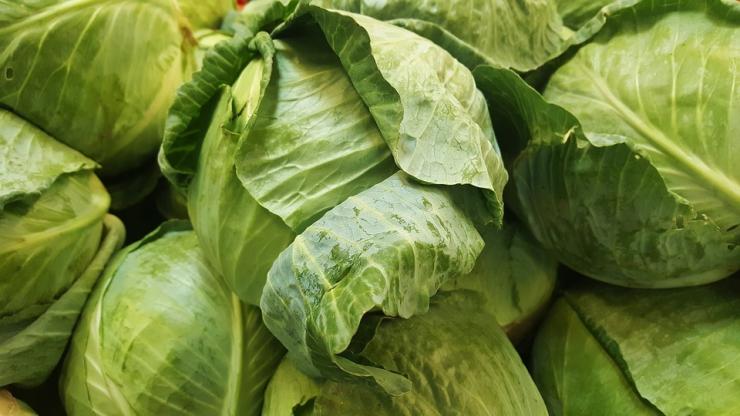
Photo: keep heads of cabbage with stalk and covering leaves
The best varieties of kohlrabi cabbage. Cleaning and storage
Particular attention must be paid to the choice of the variety. Early-ripening hybrids, which it is advisable to eat immediately, will be least preserved fresh.
For long-term storage, late varieties are best suited, characterized by a denser structure and excellent keeping quality. Purple kohlrabi varieties are stored for the longest. Here are the best varieties of cabbage for storage:
Collection rules and secrets:
- Kohlrabi is harvested upon reaching the stems with a diameter of 7 to 8 centimeters;
- In overgrown fruits, the pulp becomes hard and begins to taste bitter;
- It is necessary to harvest on a dry and sunny day, until frost occurs, at an outdoor temperature of +3 to +5 degrees;
- Stem fruits that are planned to be stored for a long time must be pulled out of the soil along with the root system;
- When cutting the leaves, it is necessary to leave small stalks from 2 to 3 centimeters, for better storage of the cabbage;
- If long-term storage of kohlrabi is not planned, then the root and stump can be cut off. Such a stem crop will be good for no more than a month;
- Cut leaves can be added to various salads as they are very healthy and tasty;
- They can be stored in bags in the refrigerator for two to three days.
Cleaning and storage in moss:
In a cellar or basement
The best place to preserve kohlrabi in the winter is the cellar. The permissible humidity in the cellar is from 95%, and the temperature regime is from 0 to +5 degrees Celsius. If these conditions are met, the early varieties of cabbage are stored for up to two months, and the later ones for several months longer. When stored in a cellar, kohlrabi will not lose its useful properties. Not all fruits are suitable for storage. It is necessary to reject stem crops:
- Immature, small (less than seven centimeters);
- With traces left by pests or diseases;
- Damaged (dents, cuts, etc.).
Storing cabbage in basements or cellars is possible in several ways:
- Prepared with trimmed leaves, vegetables are laid out in boxes or baskets. Stem fruits must be laid down with their roots, then sprinkled on top with slightly moist clean sand. Cover the top with plastic wrap. Do not close tightly, otherwise the cabbage may rot and rot will begin. It is allowed to lay the heads of cabbage on special grating or in compartments;
- You can also store cabbage in the cellar on the floor in moist sand. A layer of sand, at least 7-10 centimeters thick, must be scattered over the ceiling. Stick the kohlrabi into the sand with the roots down, preventing the fruit from touching. Otherwise, they will certainly deteriorate;
- Sometimes cabbage for the winter is recommended to be hung on a wire or rope to special hooks on the ceiling. Here, a very important condition is a fairly free arrangement of the fruits. The distance between adjacent fruits should be at least 2-3 cm.
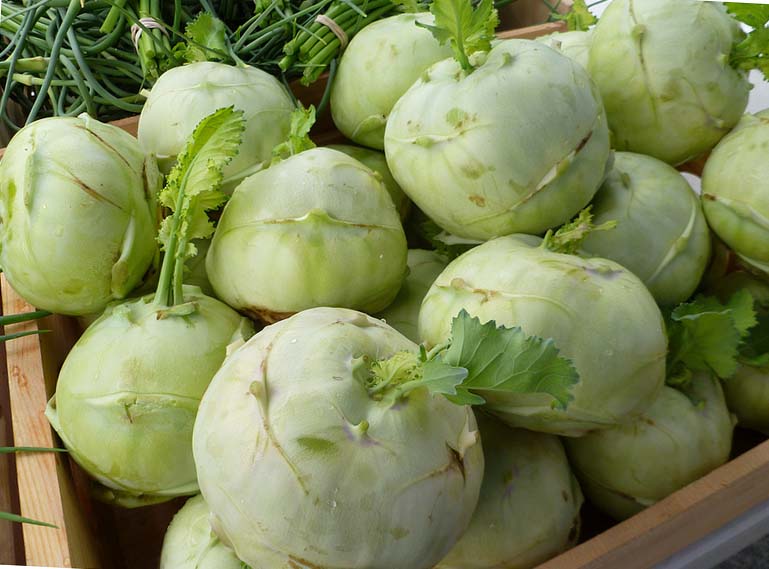
Freezing
Kohlrabi can also be stored in the freezer in winter. This is a very good way. And although frozen vegetables are not entirely suitable for preparing fresh salads, they nevertheless retain all the nutrients and vitamins in full.
The freezing technology is as follows:
- The stems need to be washed thoroughly;
- To peel;
- Cut into pieces about 2 cm thick;
- Dip in boiling water for a couple of minutes;
- then quickly move into very cold water (preferably ice cold);
- Throw in a colander;
- Pat dry on a towel;
- Arrange in individual sachets or containers;
- Store in the freezer.
You can grate the cabbage on a coarse grater. This cabbage does not need blanching. It can be immediately divided into sachets and stored in the freezer. In this form, cabbage is perfectly stored for up to 9-10 months.

Fresh in the fridge
In the absence of a cellar, you can store the stem crop in the refrigerator. Immediately after harvesting from kohlrabi, it is necessary to cut off the roots and leaves, leaving cuttings from 8 to 10 centimeters. This is necessary so that the greens do not draw juices from the rhizome, otherwise the fruit will quickly become flabby. Also, the likelihood of penetration of infection, provoking rotting, is reduced.
Each stem plant must be wrapped in paper or cotton cloth. Then place the vegetables in a plastic bag, which should not be tied tightly to allow air access. You don't have to wrap the cabbage in paper, just mark the damp cloth in the bag. Thanks to this method, the vegetable will remain tasty and fresh for two months.

